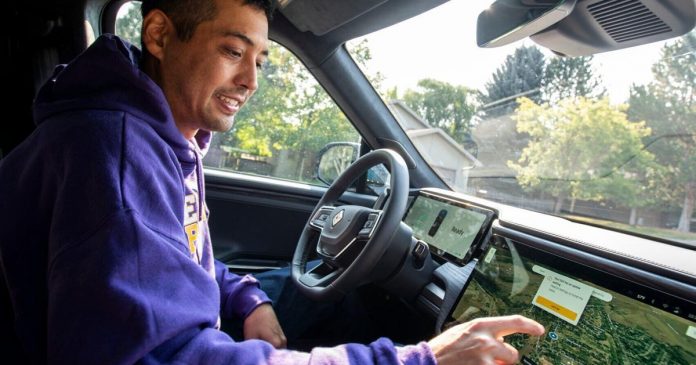Dan West believes the future of transportation in Montana sits in his mother’s driveway.
West, a Sentinel High School grad, drove a launch-edition Rivian R1S electric sport utility vehicle for his Missoula family visit, and he hopes it marks the dawn of a new era of emissions-free travel, where power cords replace gasoline nozzles.
“It’s probably the first R1S in the state,” he explained.
For the past two years, West has worked as the only Washington, D.C.-based in-house federal lobbyist for Rivian, an electric adventure vehicle manufacturer headquartered in California with a plant in Illinois. He worked with the Senate Finance Committee to get an extension of the $7,500 tax credit for electric vehicles into the Inflation Reduction Act passed by Congress and signed by President Joe Biden earlier this summer. There’s also a $4,000 credit on used EVs included in the language of the bill.
And over the next five years, Montana will receive $43 million in federal funding for electric vehicle charging infrastructure as state transportation officials expect an influx of electric cars and trucks. So Rivian hopes that the market will be hot for people who want to make the switch to all-electric SUVs.
The RS1 is a seven-seater with huge tires that can go from zero to 60 mph in three seconds with a towing capacity of up to 7,700 pounds. With a base price of $78,000, the vehicle isn’t for everyone. However, West notes that it costs just pennies to charge at home to get around town during the day. It costs between $20 to $30 for a full charge from a super-fast charger, giving the vehicle a range of 316 miles. That’s a big up-front investment, but West said the owner of the car could save thousands of dollars on gas every year.
His pitch to the staff of lawmakers like Sen. Joe Manchin was that the United States must compete with China on innovation while turning the tide of climate-altering emissions.
“China had policies like this put in place 5-10 years ago, so we’re a little late to the party,” West explained. “But this was kind of Congress’ response to that.”
West’s mom worked with Steve Running, a professor emeritus at the University of Montana who was part of a Nobel Peace Prize-winning team in 2007 for his work on climate change. West said he was inspired to work on climate issues by being around scientists like Running his whole life.
“(Running) really shaped my perspective and my career path,” he said.
Now, West says Rivian hopes to deliver 25,000 electric vehicles this year.
Officials with the Montana Department of Transportation and the Department of Environmental Quality see the writing on the wall as well.
The two departments recently submitted a plan to deploy electric vehicle charging infrastructure across the state to the federal government for approval. Over the next five years, Montana will spend $43 million in federal funding as part of a larger bipartisan infrastructure, explained Montana DEQ air, energy and mining division administrator Sonya Nowakowski in a July webinar about the rollout of the Montana Electric Vehicle Infrastructure Deployment Plan.
“We’ve developed a plan with Montanans to build a statewide reliable network of electric vehicle charging infrastructure,” she said. “I’m excited about these opportunities. Montanans developed a plan that puts us on a path to accelerated and equitable EV adoption in Montana, reduces transportation-related emissions and positions the state to be a part of electrification efforts across the nation.”
The funds will be spent along Montana’s “designated alternative fuel corridors,” which are I-90, I-15, I-94, U.S. Hwy 2 and U.S. Hwy 93.
“Montana has slower adoption of EVs compared to the rest of the nation,” said Rob Stapley of the Montana Department of Transportation. “But, given trends, we anticipate more EVs driving on Montana’s roads. Tourism plays a big role and we can anticipate tourists driving EVs in big numbers.”
Neal Ullman with the DEQ’s energy office, said the federal funding comes with the stipulation that rural areas and underserved communities get charging infrastructure. There are currently nine fast charging stations in Montana, located in Dell, Butte, Missoula, the Wye west of Missoula, Whitefish, Bozeman, Gardiner and Seeley Lake. Nine more are planned in Hamilton, Deer Lodge, Big Timber, Hardin, Billings, Dillon, Helena, Great Falls and Conrad.
Kyla Maki of the DEQ’s energy planning section said that there were 1,893 electric vehicles registered in Montana as of January 2022. Her office anticipates that there will be 130,000 electric vehicle drivers in Montana every year by the year 2030, but most of those would be out-of-state drivers.
The plan that Montana submitted to the federal government will mean that charging stations are open 24/7, no more than 50 miles apart, within one mile of an alternative fuel corridor, and within a quarter-mile of amenities like restrooms, a restaurant or retail shops.
West said Rivian is also hoping to increase the number of EVs on the road and has plans to build a $5 billion, 7,500-job electric truck manufacturing plant in Georgia.
“So the word of this year is ramp, and we’re just trying to ramp production as quickly as possible to get to full production and normal and then, of course, expand our operations footprint in the Southeast,” he said.

